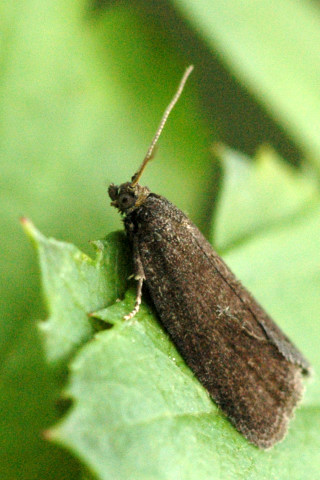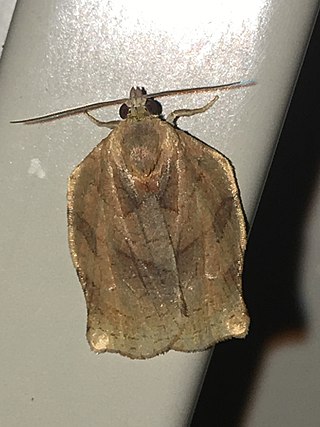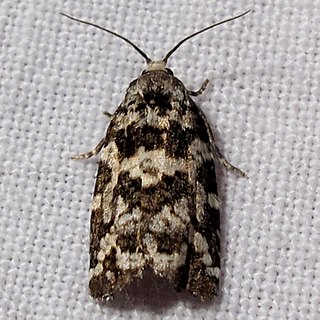
Pandemis heparana, the dark fruit-tree tortrix or apple brown tortrix, is a moth of the family Tortricidae.

Lozotaenia forsterana is a moth of the family Tortricidae. It is found in Europe and across the Palearctic.

Aphelia viburnana, the bilberry tortrix, is a moth of the family Tortricidae. It is found in Europe, from Portugal and Great Britain to the Ural Mountains, Siberia and Mongolia, further east to the Russian Far East.

Aleimma loeflingiana is a moth of the family Tortricidae. It is found in Europe and the Near East.

Eulia ministrana is a moth of the family Tortricidae. It is found in the Palearctic and Nearctic realms.
Beryllophantis is a genus of moths belonging to the subfamily Tortricinae of the family Tortricidae.

Amorbia emigratella, the Mexican leaf-roller, is a moth of the family Tortricidae. Although it was described from Hawaii, it is known to be a native of the southern United States, Mexico and Central America. It was first described by August Busck in 1910.

Apotomis betuletana is a moth of the family Tortricidae. It is found in most of Europe. It is also found in the eastern part of the Palearctic realm. The habitat consists of woods and woodland margins where birch occurs.

Platynota flavedana, the black-shaded platynota moth, is a species of moth of the family Tortricidae. It is found in the United States from Minnesota to Maine, south to North Carolina and west to Arizona.
Orthocomotis similis is a species of moth of the family Tortricidae. It is found in Costa Rica.

Cnephasia longana, the omnivorous leaftier moth, long-winged shade or strawberry fruitworm, is a moth of the family Tortricidae. It was described by Adrian Hardy Haworth in 1811. It is native to western Europe. It is an introduced species in western North America. The species has also been reported from north-western Africa and Asia. The habitat consists of downland and rough ground.

Archips purpuranus, the omnivorous leafroller moth, is a species of moth of the family Tortricidae. It is found in most of eastern North America.

Archips packardianus, the spring spruce needle moth or spruce needleworm, is a species of moth of the family Tortricidae. Spruce needle worms are commonly found in small numbers on spruce and trees of other coniferous genera throughout most of Canada and the northeastern US. Archips packardiana overwinters as a tiny larva in a mined needle. Needle mining is resumed in the spring, the larvae later moving to feed on new foliage, where they spin considerable webbing. Full-grown larvae have a pale green head, sometimes patterned with brown, and a pale body and pale thoracic legs, and are about 20 mm long. The larva pupates, usually in the webbed needles, and the adult emerges in summer to early fall. The closely related Archips strianus is much less common, but probably has a habitat similar to that of A. packardiana. The larvae have dark thoracic legs and small dark areas around the base of the thoracic hairs. The habitat consists of coniferous and mixed woods.

Epinotia nemorivaga, the bearberry bell, is a species of moth in the family Tortricidae. It is found in Europe and Asia.
Beryllophantis cochlias is a species of moth of the family Tortricidae. It is found in Papua New Guinea and West Irian. The habitat consists of montane rain-forests.
Beryllophantis alphophora is a species of moth of the family Tortricidae. It is found in Papua New Guinea.
Beryllophantis microtera is a species of moth of the family Tortricidae. It is found in Papua New Guinea. The habitat consists of montane rain forests with Nothofagus.
Beryllophantis asticta is a species of moth of the family Tortricidae. It is found in Papua New Guinea. The habitat consists of montane rain forests.
Beryllophantis poicila is a species of moth of the family Tortricidae. It is found in Papua New Guinea. The habitat consists of montane rain forests with Nothofagus.
Beryllophantis allochlora is a species of moth of the family Tortricidae. It is found in Papua New Guinea. The habitat consists of montane rain forests with Nothofagus.











